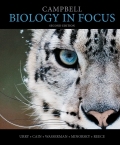
Concept explainers
The body tissue that consists largely of material located outside of cells is
- A. epithelial tissue.
- B. connective tissue.
- C. muscle.
- D. nervous tissue.
Introduction:
The connective tissues are of various types that include blood, bones and cartilage tissue. They form a layer or network of the fibrous tissue outside the cells namely osteocytes, osteoblasts in the bones, blood cells like white blood cells, red blood cells and platelets in the blood vessels and a matrix of cells in the cartilaginous tissue. The other cells in this tissue include the macrophages, mast cells, and fibroblasts. A layer of fibrous network of the connective tissue is present outside the layer of the cells in the matrix.
Answer to Problem 1TYU
Correct answer:
The connective tissue consists of several types of tissues like blood, bones and cartilaginous tissue. The cells include the osteocytes and osteoblasts inside the spongy tissue of the bones, blood cells like red blood cells, white blood cells and platelets. A layer of fibrous material is present outside the matrix of these cells in the connective tissue. Therefore, option (B) is correct.
Explanation of Solution
Reason for the correct statement:
The connective tissue forms a network of fibrous tissue outside the matrix of the cells. The cells include the osteocytes and osteoblasts inside the spongy tissues of the bones and blood cells inside the blood vessels.
Option (B) is given as “connective tissue”.
As, there is a fibrous network of the connective tissue present outside the matrix of the cells containing osteocytes, osteoblasts and blood cells inside the blood vessels supplying nutrients and gases to this tissue”, it is the right answer.
Hence, option (B) is correct.
Reasons for the incorrect statements:
Option (A) is given as “epithelial tissue”.
The epithelial tissue forms the outer covering of the layers of cells in the digestive system and respiratory system. They help in the absorption of the food in the digestive system. It does not form a material outside the cells. So, it is a wrong answer.
Option (C) is given as “muscle”.
It is made up of protein fibers like actin and myosin, which help in the locomotion and movement of the body. It does not form a material outside the cells. So, it is a wrong answer.
Option (D) is given as “nervous tissue”.
The nervous tissue consists of the brain. It does not form a material outside the cells. So, it is a wrong answer.
Hence, options (A), (C), and (D) are incorrect.
The connective tissue forms a network of the fibrous material outside the cells of the matrix like osteoblasts and osteocytes in the bones, blood cells in the blood vessels and other cells like fibroblasts and macrophages.
Want to see more full solutions like this?
Chapter 32 Solutions
Campbell Biology In Focus
Additional Science Textbook Solutions
HUMAN ANATOMY
Biological Science (6th Edition)
Campbell Essential Biology (7th Edition)
Chemistry & Chemical Reactivity
Biology: Life on Earth with Physiology (11th Edition)
Laboratory Manual For Human Anatomy & Physiology
- Not part of a graded assignment, from a past midtermarrow_forwardNoggin mutation: The mouse, one of the phenotypic consequences of Noggin mutationis mispatterning of the spinal cord, in the posterior region of the mouse embryo, suchthat in the hindlimb region the more ventral fates are lost, and the dorsal Pax3 domain isexpanded. (this experiment is not in the lectures).a. Hypothesis for why: What would be your hypothesis for why the ventral fatesare lost and dorsal fates expanded? Include in your answer the words notochord,BMP, SHH and either (or both of) surface ectoderm or lateral plate mesodermarrow_forwardNot part of a graded assignment, from a past midtermarrow_forward
- Explain in a flowcharts organazing the words down below: genetics Chromosomes Inheritance DNA & Genes Mutations Proteinsarrow_forwardplease helparrow_forwardWhat does the heavy dark line along collecting duct tell us about water reabsorption in this individual at this time? What does the heavy dark line along collecting duct tell us about ADH secretion in this individual at this time?arrow_forward
 Biology (MindTap Course List)BiologyISBN:9781337392938Author:Eldra Solomon, Charles Martin, Diana W. Martin, Linda R. BergPublisher:Cengage Learning
Biology (MindTap Course List)BiologyISBN:9781337392938Author:Eldra Solomon, Charles Martin, Diana W. Martin, Linda R. BergPublisher:Cengage Learning Human Physiology: From Cells to Systems (MindTap ...BiologyISBN:9781285866932Author:Lauralee SherwoodPublisher:Cengage Learning
Human Physiology: From Cells to Systems (MindTap ...BiologyISBN:9781285866932Author:Lauralee SherwoodPublisher:Cengage Learning
 Concepts of BiologyBiologyISBN:9781938168116Author:Samantha Fowler, Rebecca Roush, James WisePublisher:OpenStax College
Concepts of BiologyBiologyISBN:9781938168116Author:Samantha Fowler, Rebecca Roush, James WisePublisher:OpenStax College





